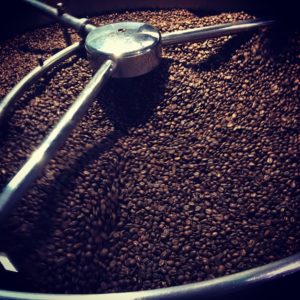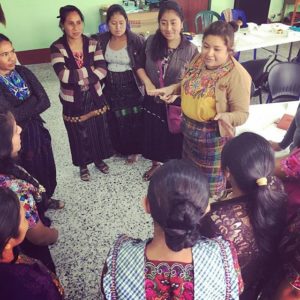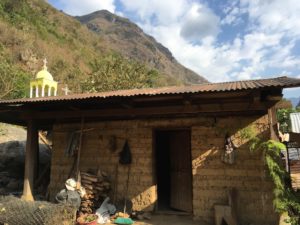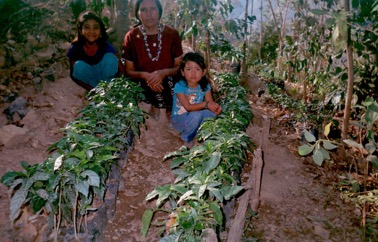Catalyst Award recipient Alissa Bilfield traveled to Guatemala in April 2017 to conduct research for her dissertation, where she is investigating food security and the dynamics of women’s membership in Fairtrade organic coffee cooperatives. Alissa is a doctoral candidate in Public Health at Tulane.
Behind that cup of coffee that you drink every morning is a whole supply chain of businesses and people, leading all the way back to the producers who pluck every coffee cherry from each coffee tree. All along the ‘coffee belt’ in the tropics coffee is a huge industry, steeped in a colonial history of domination and exploitation.
 Guatemala is particularly famous for its coffee, and the green coffee bean still ranks as the country’s top export product. But since the Fairtrade cooperative movement has gained momentum globally, coffee has become more than just a cash crop, but a vehicle for small-holder coffee farmers to achieve market inclusivity and to promote collective community development. For thousands of Indigenous Maya living at higher altitudes in the mountainous highlands of Guatemala, Fairtrade organic coffee has become an avenue not only for fairer prices, but for environmental stewardship and social and enhanced economic justice. Interestingly, in the last few decades more women have become formal members in coffee cooperatives, and this is where my research in the Western Highlands comes in.
Guatemala is particularly famous for its coffee, and the green coffee bean still ranks as the country’s top export product. But since the Fairtrade cooperative movement has gained momentum globally, coffee has become more than just a cash crop, but a vehicle for small-holder coffee farmers to achieve market inclusivity and to promote collective community development. For thousands of Indigenous Maya living at higher altitudes in the mountainous highlands of Guatemala, Fairtrade organic coffee has become an avenue not only for fairer prices, but for environmental stewardship and social and enhanced economic justice. Interestingly, in the last few decades more women have become formal members in coffee cooperatives, and this is where my research in the Western Highlands comes in.
Thanks to support in part from the Taylor center, I had the opportunity to conduct field work for my doctoral dissertation this spring and summer in the Huehuetenango department of Guatemala with an amazing cooperative called COMAL (Comercializadora Maya Alternativa) that is part of a larger federation of coffee cooperatives called FECCEG (Federacion Comercializadora de Cafe Especial de Guatemala).
While I was in Guatemala I was based out of the colonial capital in the western highlands of many names, called Quetzaltenango, Xela – and some still call it Xelaju. This is where FECCEG, the coffee federation is based. I was fortunate to sit in on a women’s leadership and financial literacy workshop while I was there, where women coffee producers from across all of the coffee cooperatives came together to learn from each other, share their experiences, and gain expertise
Women’s formal participation in coffee is relatively new, although they have been active in the coffee harvest all along. Now as members and leaders in cooperatives, they are gaining more decision-making power and influence, ultimately benefiting their family’s welfare.
I also had the opportunity to spend time conducting research at COMAL’s headquarters in Huehuetenango, far up in the Sierra Madre del Occidente. Up the windy path towards the border with Mexico sits the cooperative’s office, surrounded by peaks. It was the dry season, just after the harvest, so farmers had time on their hands to participate in research.
 I also had the opportunity to spend time conducting research at COMAL’s headquarters in Huehuetenango, far up in the Sierra Madre del Occidente. Up the windy path towards the border with Mexico sits the cooperative’s office, surrounded by peaks. It was the dry season, just after the harvest, so farmers had time on their hands to participate in research.
I also had the opportunity to spend time conducting research at COMAL’s headquarters in Huehuetenango, far up in the Sierra Madre del Occidente. Up the windy path towards the border with Mexico sits the cooperative’s office, surrounded by peaks. It was the dry season, just after the harvest, so farmers had time on their hands to participate in research.
I worked together with an amazing team of local research assistants, all fluent in the local Mayan language, Mam. We facilitated interviews with 30 of the cooperative members, and a photovoice project with the women cooperative members. Through the photovoice project, women took photographs of their daily lives, their coffee trees, and their farms. The results of the photovoice project were truly spectacular. One participant, pictured here, curated this beautiful photo with her children and their coffee plants. Through my field work I learned directly from men and women cooperative members about their perspectives on the benefits of membership in a Fairtrade organic coffee cooperative, and the process by which gender norms have been changing as a result of women’s formal participation  and leadership in the cooperative. From this research I plan to continue using community-based participatory action research to better understand the role of cooperatives in collective social entrepreneurship using an intersectional lens. Many thanks to the Taylor team for all of the work they do supporting student research and scholarship around social entrepreneurship and innovation.
and leadership in the cooperative. From this research I plan to continue using community-based participatory action research to better understand the role of cooperatives in collective social entrepreneurship using an intersectional lens. Many thanks to the Taylor team for all of the work they do supporting student research and scholarship around social entrepreneurship and innovation.
